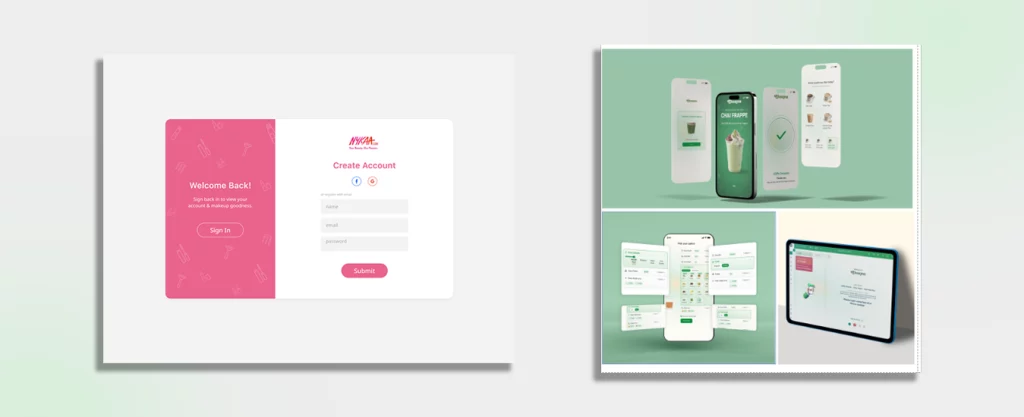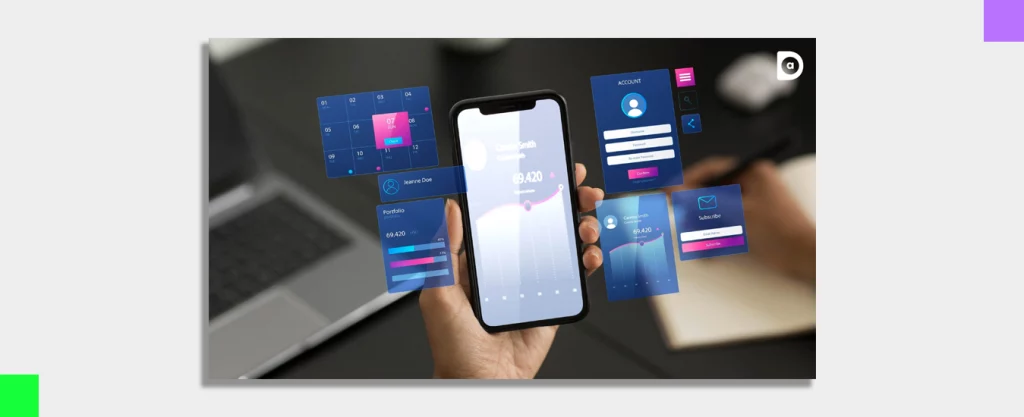93% of people search online before hitting the store
Introduction
The importance of UI/UX in business in this digital era cannot be overstated. It is the very first point of intentional contact between the brand and the customer. This virtual presence of the brand significantly impacts the perception of the business, nurtures the audience’s trust, and determines their response. What goes behind the scenes of an incredibly consumer-centric UI/UX design is the brand’s values to understand the audience, empathize with their needs, research extensively, and most importantly, test the usability of the digital product. In a nutshell, it is about catering to a range of customer demographics, providing ease of access, and crafting a personalized consumer experience.
This article will focus on breaking down how D2C e-commerce brands are growing and creating a strong brand presence. How are these brands using UI/UX to foster the success of the brand? And how the pivotal role of UI/UX in e-commerce pitches to the new and nurtures the existing customer base.
What is D2C business?

Direct-to-consumer (D2C) is a business model where businesses sell their products directly to consumers. In this way, the process is streamlined without the intervention of any middlemen (retailers). This modern business model gracefully spirals out of the two most pressing challenges of traditional business practices. One is the disconnect in customer data and the second is the preferability of brand promoters. With the brands directly selling to end customers via D2C websites, the intuitive UI/UX design renders full control of customer data and allows highly personalized customer experiences. Brands now stand the opportunity to promote themselves and are not subject to the biases of retailer’s preferences.
Some D2C brands in India include Boat, Mamaearth, and Bewakoof.
What is the importance of UI UX in D2C website design?

D2C businesses sell directly to their end customers. This means that the brand’s website plays the role of a salesperson and the virtual face of the brand, who introduces the business. It’s the real hero. The realm of UI/UX design goes beyond aesthetics and delves deep into user perception and human behavior, eliciting positive emotions and decision-making. Having a well-structured UI smooths the interaction of the customer with technology and they feel welcome and cared for. For example, Nykaa’s sign-up page is a quick one-step process with email ID verification followed by the UI leading the user by hand and introducing the app.
To understand in-depth, have a look at this case study of one of our clients, Chaayos, a F&B Industry from India. The major issue faced by our client, Chaayos, was poor user retention and less than 50% repeat frequency in delivery and dine-in verticles. This was because of the unappealing UI of the app and we also realized that the Point of Sale (POS) for placing orders was highly complicated.
The solution we provided had a new and improved UI of the cafe app that boosts user retention. New features were also added that encouraged the user to try new customization options on the menu. The redesigned POS system was a one-click system that streamlined the order-taking and completion system with simpler options to choose from.
The massive impact the UI redesigning had was seen in the markedly better user retention, a systemic order-taking system, efficient rush hour management, and successful order completion.
Did You Know?
Even facts say that $1 invested in UX design brings an ROI of approximately $100.
Benefits of UI/UX in D2C Startups

1. Fast and easy access
Decreased loading times from an optimized UI/UX help people globally find products from D2C startups within seconds. Simple UI interfaces keep customers coming back every day to quickly find what they need and add to the cart.
2. Mobile First
M-Commerce market share is around 60% of the total e-commerce market. The UI/UX of m-commerce sites is specifically intuitive by design and mindful of buyer behavior and motivation. Thus, the features of “Wishlist” and “Add to Cart” are strategically placed in the most accessible top left corner.
3. Product reviews
A single glance of a well-researched D2C UI hones the ability to navigate and solve the consumer’s needs. It displays valuable data and encourages the consumer to make very satisfactory and highly informed choices. Product Ratings, Options to comment, and asking questions to fellow customers speak transparency about the brand and boost the trust of the customer. Many D2C brands categorize comments as ‘Good, Bad, or Average’ and attach links to the respective categories making it easier for the customers to scrutinize the reviews.
4. Price comparison
UI/UX allows comparison Within the app with comparison tables. This design feature has been applauded since its introduction in Myntra. It gives a bird’s eye view of your recent interests in a tabular form comparing prices, ratings, and other important specifications all in one place. This promotes a hassle-free and memorable shopping experience. The royalty to compare and make wholesome decisions is unmatched and keeps the customers coming back for the experience.
D2C vs B2C
| D2C e-commerce | B2C e-commerce |
| Direct-to-Customer (D2C) UI/UX involves direct engagement with customers with highly tailor-made user experience in the absence of middlemen. | Business-to-customer (B2C) UI/UX has less personally handcrafted experience with the end user because of the presence of retailers or middlemen. |
| The brand has access to first-hand customer data and feedback. D2C brands in India Lenskart, Bombay Shaving Company, Noise, and Sugar Cosmetics | 2. The brand does not have direct control over customer data and this may cause a disconnect with the user experience. B2C brands in India Amazon, Ola, Swiggy, Nykaa, |
Did You Know?
Based on the current research and surveys, more than 55% of online consumers prefer to shop from their manufacturer’s website (D2C websites) over the retailer’s.
How can UI/UX improve the ROI of D2C Brands?

1. Attracts new customers
First impressions matter. The global search engine market on Google accounts for 91.54%.
In today’s world, D2C brands have an audience with a small attention span, but it is also a shared audience because of innumerable competitors. The use of high-resolution images in the SERP, followed by the fast and responsive UI of D2C brands, keeps customers hooked the moment they visit. Furthermore, the front-load placement of the feature “Filter by colour, price, type” motivates the customer to look for more.
2. Boosts Engagement
Approximately 60% of digital consumers regard the usability of digital platforms as a defining feature of web and app design. Carefully researched UI/UX for the specific target audience promotes good control over Consumer Engagement and Brand Messaging, targeting and retargeting potential warm audiences. An exciting feature is the ‘Try On’ option on Lenskart, where you can check the look of the frames on yourself in real time. On similar grounds, the ‘Try On’ option of other D2C brands like Myntra.
3. Product Accessibility and Visibility
Subconsciously, the audience has comparative experience analysis and is naturally inclined toward ease and fast results. The intuitive, UI of brands like Bewakoof has the option of “See Similar Products” or ‘You May Also Like’ which opens a pool of possible interest to the consumer. The UI of Myntra also classifies products into various categories and subcategories. For example, under the Mens Category, some of the subcategories are ‘Daily Wear’’, ‘Party Hits’, and even ‘Active Wear’. Thus, navigation through the app is quick and simple.
4. Brand presence
The brand has won halfway if the audience can recall the brand by its visuals, experiences, values, and personality. Here, consistency in the values and visual presentation is key. It is how consumers think of a pink-themed UI and mentally picture Nykaa and Bewakoof’s UI in yellow. This imprints the brand’s UI in the consumer’s subconscious memory. It also corresponds to how the brand is at the top of the niche by having exclusive UI/UX features like ‘Streaks’ on the Headspace app or Duolingo app.
5. Retain loyal customers
The gems in your audience are the loyal customer base. Every time they leave satisfied, they will intuitively come back again looking for the same satisfying customer experience. UX of Nykka Prive offers Premium call assistance to Prive Customers, The UI of the app highlights a small badge on the top right corner reading NykaaPrive. Edge over competition
The equation is just this: Smoother experience = Better interaction = More response
Smooth UI / UX will keep the brand stay ahead of the competition and successfully leave the weaker competitors behind.
6. Saves Developmental costs
Investing in optimizing UI/UX reduces long-term costs and evidence of this is found in case studies and industry reports. By involving UX design early in the development process, organizations can catch and fix usability issues before they become major problems. This can save time and resources in the long run and prevent costly rework.
7. Build Credibility
The UX portrays the brands as those who know the business and are reliable and secure. In UX, designing for trust is about creating digital products that customers can feel safe and secure in, ingraining a sense of credibility that encourages users to engage with a product or brand. For example, the UI of Lenskart displays the Customer Service number in the top right corner. This assures the customer that they can reach out if needed.
Conclusion
UI/UX is the backbone of all digital interactions and will continue to impact the brand’s presence in every area of commerce. A seamless navigation, clear calls-to-action, and an intuitive user flow help get massive conversion funnel success. Not only that, but it is also the secret to standing out and keeping ahead of the competition.
Don’t know how to design? Reach out to us and let’s create tailor-made user experiences and a memorable brand presence.
FAQs about UX UI in D2C brand’s success
What is the growth rate of d2c brands?
Owing to digital platforms, the D2C market is expected to surpass $100 billion by 2025.
Why is UX important for business?
In the digital world, UX speaks for businesses. D2C, being extremely customer-centric and led by the user’s insights, drives the brand’s success and next move.
Why are brands moving to D2C?
Businesses want to sell directly to their customers to enhance the customer experience and also reduce the shared margin.




